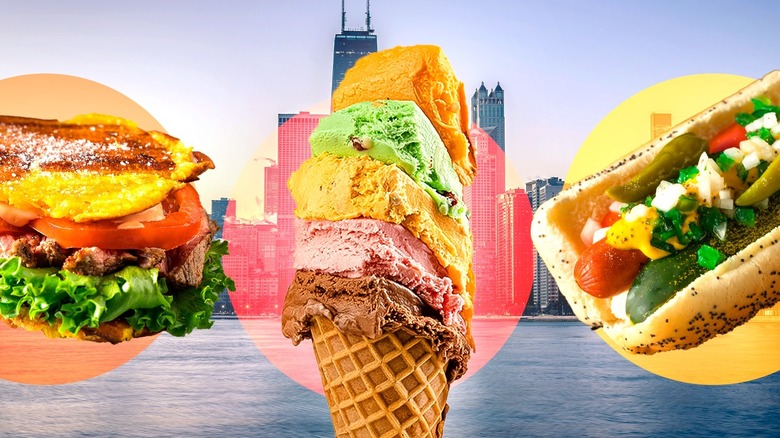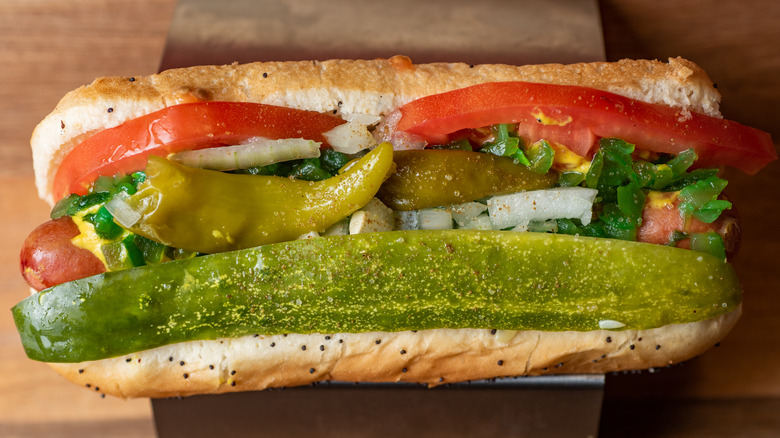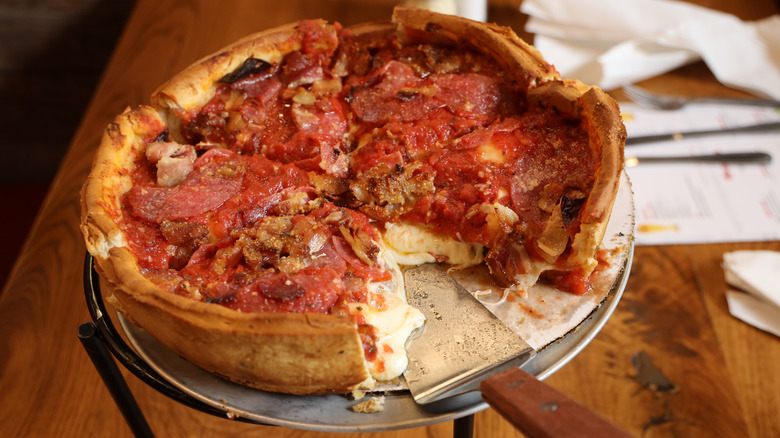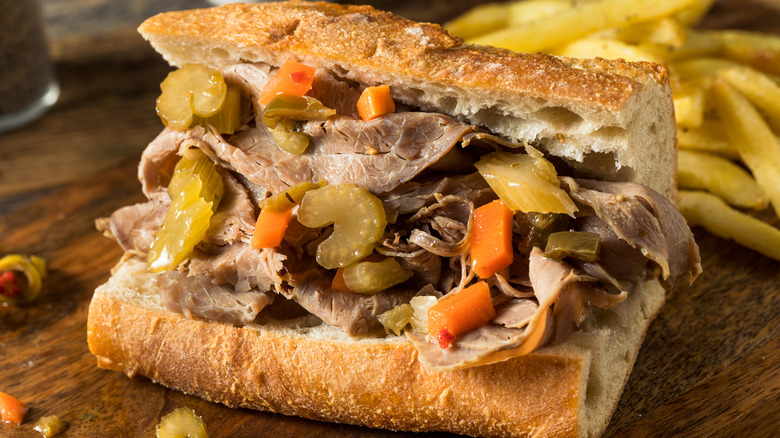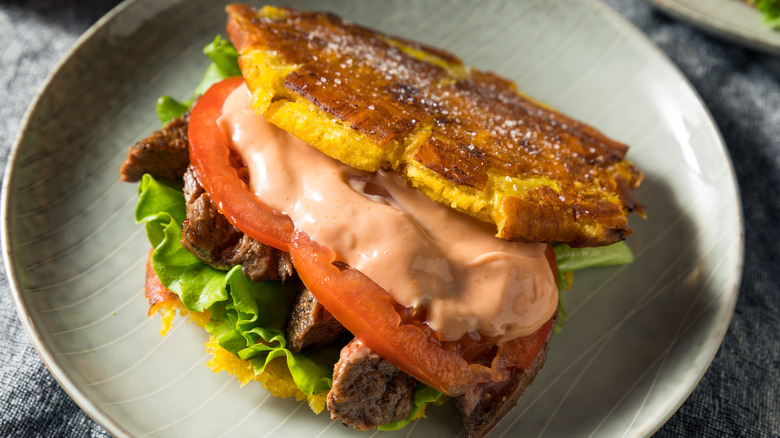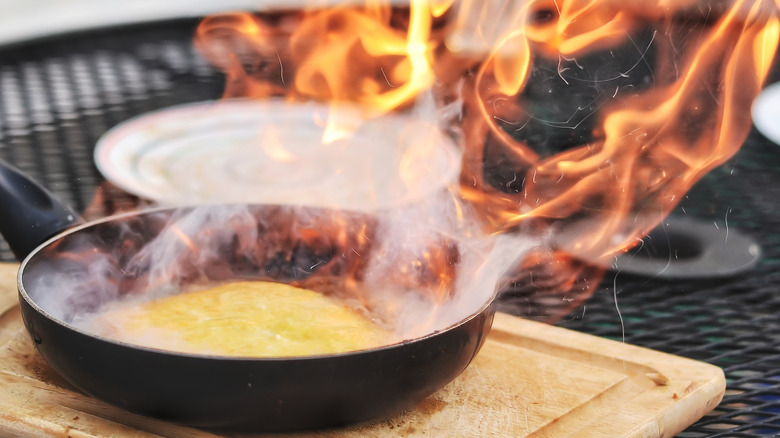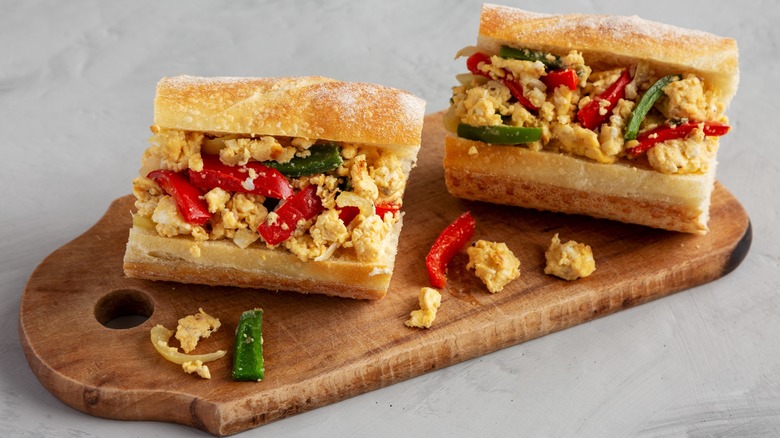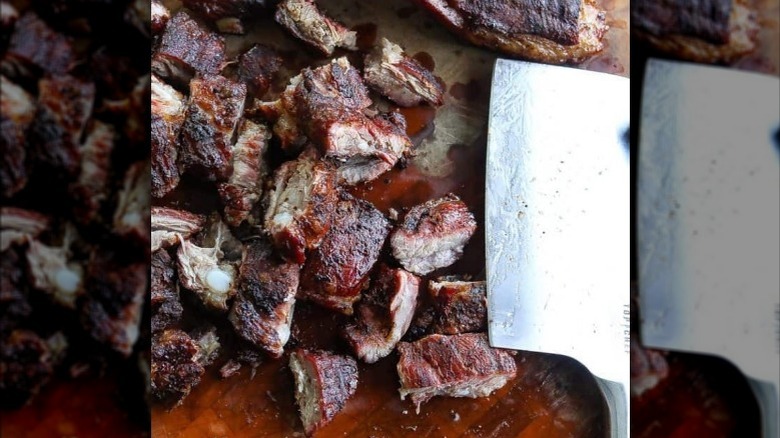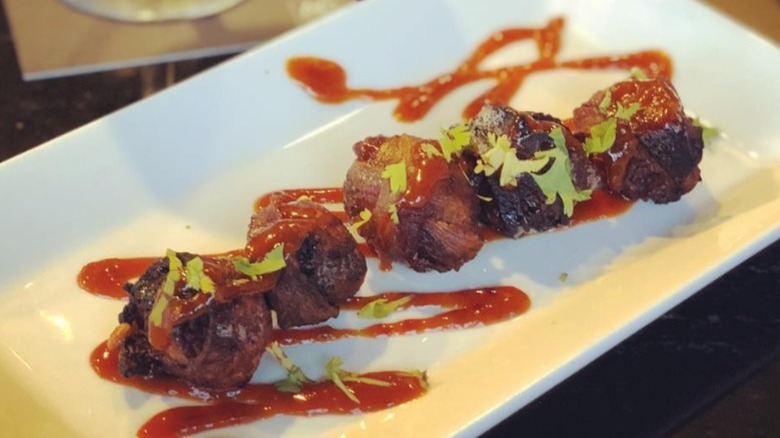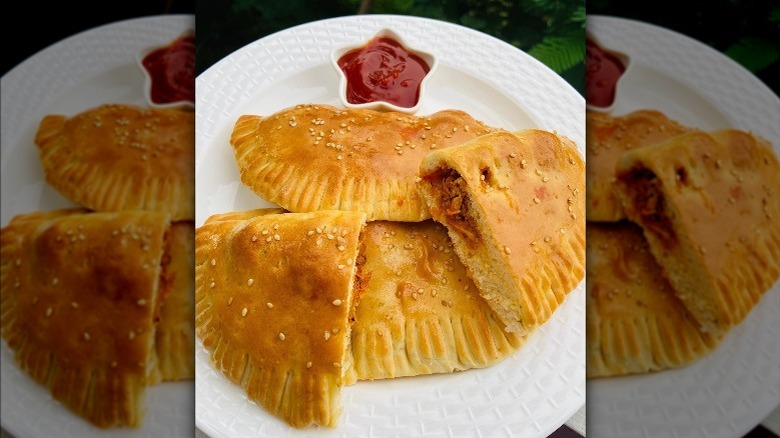12 Classic Chicago Foods You Need To Try Before You Die
To call Chicago a food town might be an understatement. Nearly every summer since 1980, the Windy City has hosted Taste of Chicago, one of the largest food festivals in the United States. Over 1.5 million people brave the heat and humidity to gather downtown along the sparkling Lake Michigan shore to enjoy the summer sunshine, live musical performances, and, of course, dozens of food trucks and pop-up restaurant stalls.
But you don't need to head to Taste of Chicago to enjoy a taste of Chicago. A city of immigrants has given birth to a number of new foods and signature dishes, some of which have gone on to be embraced by the world. William Wrigley, Jr. started selling his now famous gum in Chicago. Brownies were created in the kitchen of Chicago's Palmer House, where the original recipe is still used today. In 1930, the Continental Baking Co., located in a suburb of Chicago, introduced the world to Twinkies.
Of course, there are also a ton of Chicago foods that remain more locally beloved, and help to define the culinary and cultural destination. For a more singular and unique sampler of the Second City (yet another nickname), we suggest seeking out these 12 iconic Chicago foods, especially the ones you won't find anywhere else.
1. Chicago dog
To many of us, a hot dog is a hot dog. You take a cooked sausage, nestle it into a long, slit bun, and put whatever condiments suit your fancy on top. Right? Not in Chicago. The Chicago-style hot dog, also known as a Chicago Dog, is not just any hot dog. There are rules to follow.
First, there is the bun. The steamed poppy seed bun to be exact. Next comes the steamed, typically all-beef sausage. Lastly, there are the seven toppings, which all should be added in a precise order to ensure that you get the perfect bite every time, no ingredient left out. Vienna Beef was happy to provide an instruction video on YouTube. The specific order of assembly is: yellow mustard, "neon green" relish, chopped onions, two wedges of sliced tomato, two sport peppers, a pickle spear, and a dash or two of celery salt.
Woe be to anyone who wavers from this method. When The New York Times shared its recipe for a Chicago Dog, fans were quick to correct them in the comments. The bun must be steamed, not toasted or grilled. And, as one person put it, "Ketchup must not be allowed within 30 feet of the [Chicago-style] hot dog."
2. Chicago-style pizza
New York versus Chicago-style pizza is a well established rivalry in the United States. Which is better? New York's traditional thin crust or Chicago's innovative deep dish? We aren't here to settle that perpetual debate. But we are here to tell you about this renowned icon of the Windy City.
Chicago-style pizza was first created in 1943 by Ike Sewell and Ric Riccardo for their Near North Side neighborhood restaurant Pizzeria Uno. Their Chicago-style pizza is essentially an inversion of the traditional Neapolitan pizza. A pan with deep sides is used rather than a flat surface. The mozzarella cheese is put onto the dough first, followed by "toppings" like meat and vegetables, and then the sauce is ladled on last. In restaurants, a special pizza pan gripper is used to deliver the piping hot pies fresh from the oven to customers. A slice of Chicago-style pizza is thick and hearty, so it's best to use a sturdy pie server to move one to your plate.
Pizzeria Uno long ago expanded and is now a chain called Uno Pizzeria and Grill with locations as far east as Maine and as far west as Colorado. You can even find a few locations abroad in both Saudi Arabia and India. But the original Pizzeria Uno is still in operation in Chicago, serving up its claim to fame to hungry customers seven days a week.
3. Italian beef sandwich
In the early 20th century, Chicago-native Anthony Ferreri made sandwiches and other baked goods in his basement. He then drove around Chicago selling them to make ends meet. One day, while attending a wedding reception where roast beef was being served, Ferrari got an idea. Why not slice the beef thinly on his deli slicer and sell it in a sandwich? Thus the Italian beef sandwich was born.
Eventually, Ferrari's son Albert, daughter Frances, and son-in-law Chris opened up a food stand to sell the beef sandwiches. They named the business Al's Bar B-Q, but the name was changed to Al's #1 Italian Beef in 1980. The original location remains open today, still serving their famous sandwich.
Al's was featured on the Food Network's "Top 5 Restaurants," where the secret to Al's nearly century-long success was revealed. The beef is roasted in a bath of garlic cloves and a special secret seasoning mix. It is then very thinly sliced and put in a second soak of gravy (elsewhere called au jus) to marinate further. The meat is removed with a special fork and put onto a long slice of bread, like a sub. It is topped with giardiniera, a kind of spicy relish, and then served wet, with a little gravy on top, or dipped, with the entire sandwich submerged in the gravy bath.
4. Jibarito
Jibaro is a Puerto Rican term for someone from the countryside. But in Chicago, both jibaro and its diminutive, jibarito, have a totally different meaning — a jibarito is actually a unique and delicious sandwich.
The jibarito's creator, Juan C. Figueroa, told the Chicago Tribune that he was inspired after reading an article in a Puerto Rican newspaper about using fried plantains in place of bread to make a sandwich. He tried out his own version on his father, who became a big fan and told his son that he should start offering it in his restaurant. To call the new addition to the menu a success would be an understatement. "Our reputation spread by word of mouth and just kept selling them and selling them until I started getting lines out the door," said Figueroa. This quickly led to other restaurants copying the sandwich and selling their own versions, which didn't bother Figueroa. If he had patented the sandwich, it wouldn't be as widely enjoyed throughout the Midwest as it is today.
A basic jibarito is a steak sandwich with lettuce, tomato, and mayo, but variations abound. Some jibaritos are topped with sliced cheese or grilled onions. Papa's Cache Sabroso, a Puerto Rican restaurant in the Humboldt Park neighborhood, offers jibarito made with the traditional steak, chicken (which Papa's is famous for), or without either to keep it vegetarian. For Figueroa's original recipe, you must head to his Borinquen Restaurant.
5. Flaming saganaki
Saganaki is a fried semi-hard cheese named for the heavy, two-handled pan in which it is made. It is a popular Greek snack enjoyed with a glass of beer or ouzo. However, if you are in the United States, you might know saganaki for more than its flavor — here, saganaki is often set on fire.
Although you might find flaming saganaki in some of the more touristy parts of Greece, it was really an American invention. Flaming saganaki was first served at the Parthenon restaurant after it was opened in Chicago's Greektown in 1968 by brothers Bill and Chris Liakouras. What makes the flame is a splash of ouzo or brandy added to the pan with the fried cheese. The liquor is then set on fire by the server, much to the delight of customers who traditionally yell, "Opa!," a Greek exclamation of surprise and excitement.
Sadly, the Parthenon permanently closed its doors in 2016. But the tradition of flaming saganaki that it gave birth to has spread to Greek restaurants all across the United States and Canada. For that, we can only give thanks and say, "Opa!"
6. Chicken Vesuvio
As with many dishes that are about a century old or more, the origins of chicken Vesuvio are murky. According to The Eagle-Tribune, the general consensus is that it was first served in the 1930s at Chicago restaurant Vesuvio's. The New York Times points out that it bears some resemblance to southern Italian roast chicken dishes. Regardless of its origins, the traditional chicken Vesuvio recipe calls for chicken, hence the name. However, nowadays you can also find steak Vesuvio and shrimp Vesuvio. Whatever the meat (or lack thereof for a vegetarian version), the recipe is simple and requires only one pan, which leads to easier cleanup.
For chicken Vesuvio, you start with browned chicken. Any part of the chicken is appropriate, bones and skin optional. Potatoes, peas, garlic, various herbs, lemon, butter, and white wine complete the dish. This is the perfect meal to pair with a glass of wine, and the Chicago Tribune offers several suggestions. The beverage manager of one restaurant where chicken Vesuvio is a signature dish said, "I'd probably recommend a pinot grigio or a sauvignon blanc." Another wine expert agreed, adding, "It's always wise to pair Italianesque cuisine with Italian wine."
7. Pepper and egg sandwich
The Italian beef sandwich is popular with Americans of Italian descent in Chicago. But what does this largely Catholic community do during Lent, when meat is forbidden on Fridays? Enter the pepper and egg sandwich.
The history of this uniquely Chicago sandwich has roots all the way back in the 19th century. It is said that Italian immigrants came up with the idea. But who the first person was to mix scrambled eggs with sliced peppers and sandwich them between slices of French or Italian bread is anyone's guess. Executive director of the University Village Association, Kathy Catrambone, told Block Club Chicago, "It's the best thing about Lent. You get to eat pepper and egg sandwiches."
Restaurant owner Tony Dominici told the Chicago Sun-Times that his recipe calls for three to four eggs in each sandwich plus a blend of six spices that are a family secret he inherited from his grandparents. Deli owner Michael Fiore, who uses spiced and roasted peppers in his sandwiches, told Block Club Chicago that he started off selling pepper and egg sandwiches only during lent, but due to their popularity they are now a regular part of the year round menu. Nacho Bautista also serves egg and pepper sandwiches year round at his restaurant, and puts what he calls a Sicilian spin on the original that includes diced potatoes.
8. Chicago-style popcorn
Who doesn't love popcorn? It can be served plain with butter or salt, or dressed up with flavors to make a sweet or savory snack. You can also have it as both a sweet and savory snack with Chicago-style popcorn, also known as the Garrett Mix.
The Garrett family behind Garrett Popcorn are actually from Milwaukee, Wisconsin, but they moved to Chicago in 1949. One of the gourmet popcorn shop's recipes was caramel corn known as CaramelCrisp. Garrett's also made a cheese popcorn called CheeseCorn. Mix these two together, and you have what has become known and beloved as Chicago-style popcorn. Garrett Popcorn's senior vice president of marketing, Adrienne Kardosh, credits Garrett's customers for this unique creation. "Customers would buy a bag of CaramelCrisp and a bag of CheeseCorn, then ask for a third, empty bag. They would shake the two recipes together," she told InsideHook. "We had the good sense to put it on the menu in 1977, and the rest is history." Since then, many of Garrett's competitors across the U.S. have adopted the popular mix as well.
Tins of this popcorn have become a popular gift at Christmas time, but this sweet and savory popcorn can be enjoyed at any time.
9. Rainbow cone
Popcorn is great and all, but what about if you want a real dessert? An ice cream cone, perhaps? Chicago supplies that too, in the form of the Original Rainbow Cone. This treat features five flavors in one cone: chocolate, strawberry, Palmer House (New York vanilla with cherries and walnuts mixed in), pistachio, and orange sherbet.
This incredibly unique cone with its multiple distinct flavors was the brainchild of Joseph Sapp, who opened his first ice cream stand in Chicago with his wife Katherine in 1926. When the Sapps became too popular for their little stand, they relocated to a larger location across the street. The shop is still open and serving up Original Rainbow Cones today, owned and operated by their granddaughter Lynn.
Lynn had big plans for her grandparents' ice cream creation, which has remained unchanged for almost a century. She and the Rainbow Cone have made appearances at Taste of Chicago and Lollapalooza, one of the world's largest music festivals. There are over 10 Rainbow Cone locations across Illinois, Indiana, and Florida, plus a small fleet of bookable ice cream trucks and carts.
10. Rib tips
There are numerous regional varieties of barbecue in the United States. Some are focused on a state, like Texas, Kentucky, or North Carolina. Others are city focused, such as Kansas City, Memphis, or, you guessed it, Chicago.
As told by the Columbia Daily Tribune, African Americans brought a love for barbecue with them during the second Great Migration of the 20th century. Because the traditional open pit style of barbecuing was not allowed in the crowded Windy City, the aquarium pit was born. An aquarium pit is a large metal contraption with glass sides and a sliding door. Wood or charcoal is put on the bottom of the glass part, and the meat is placed on a tray that hangs from the top.
Rib tips, or just tips to locals, are Chicago's contribution to the world of barbecue. They are juicy nuggets of meat and cartilage from the bottom of pork spare ribs. They are served atop a mound of French fries with slices of white bread on top to sop up the last of the bits of barbecue. According to the Southern Foodways Alliance, the tips are served with sauce on the side and usually orders are to go.
11. Chorizo-stuffed bacon-wrapped dates
Sometimes a dish comes along that is too good not to spread like wildfire. Such are the Chorizo-Stuffed Bacon-Wrapped Dates created for Chicago's chic restaurant Avec. Chef Koren Grieveson, who once worked at Avec, told Grub Street that these decadent dates were invented by chef Paul Kahan. To avoid wasting any cuts of meat, the chorizo is "usually pork-based, it'll sometimes have beef scraps in there, some house-made guanciale, it's all really rustic, rustic sausage," said Grieveson. This is stuffed into pitted medjool dates, which are then wrapped in bacon and braised with a special piquillo and tomato sauce.
Chef Chris Cosentino called the dates "decadence on decadence." He went on, "They're unctuous, rich, sweet, almost fatty in a way ... and the [piquillo] has such a nice heat balance." If you look online, you will find a number of copycat recipes, including one by Melissa Clark for The New York Times. But there is nothing quite like the original. And for that, there is no choice but to go to Avec in Chicago. Try following Chef Cosentino's advice and order a plate with a glass of wine.
12. Butter chicken calzone
Butter chicken is a popular style of curry found in many Indian restaurants. A calzone is like a stuffed pizza made popular by Italian restaurants. Chicago chefs Zeeshan Shah and Yoshi Yamada came up with a brilliant marriage of the two for their fusion restaurant, Superkhana International, the butter chicken calzone. Chef Yamada told the Chicago Tribune that "there's so much more (to Indian cuisine) than curry and rice. Why not challenge ourselves to create a delicious menu without rice as a central focus?" Shah elaborated on the suggestion of creating a butter chicken calzone, "We all started laughing, but then we were like, 'We should do that!'" And we are so grateful that they did.
The crust is made from traditional Indian naan bread rather than pizza dough, which perfectly suits the rich curry and melted mozzarella and Amul cheeses inside. The pair of innovative chefs told Food & Wine that the entire process to make the perfect curry and naan takes three days. It also took them several tries to get the recipe for the naan dough just right.
The success of the butter chicken calzone mirrors the city of Chicago. A blend of different cultures coming together to make something truly delicious and unforgettable.
